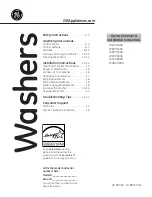
INSTRUCTION MANUAL FOR DISHWASHERS
Page 9 of 10
UK
5.4
Cleaning the arms
The wash and rinse arms are easily removed in order to clean their nozzles and prevent
blockage/encrustations.
Proceed as follows (
Fig.10
):
•
Undo nut
R
and remove the arms.
•
Wash all parts under a jet of running water and clean the nozzles thoroughly, using a toothpick or
pointed tool if necessary.
•
Clean the arm rotation pins inside the machine and the wash and rinse water drainage area.
•
Restore the arms and check that they rotate freely.
Chap 6
SELF DIAGNOSTICS
The machine is equipped with a self-diagnosis system that registers and warns of a number of
malfunctions via the fast-flashing LEDs. The table below described the malfunctions recorded
Fast flashing
•
Electro-mechanical safety device.
The boiler or tub safety thermostats have cut in, or the tub level safety pressure
switch has been triggered. Check that the drain is not blocked. Switch the
dishwasher off and then on.
Power LED
•
Water filling in tank fault
.
The tank has not filled correctly. Check the water supply and/or the presence of
the overflow. Switch the dishwasher off and then on and fill again.
•
Rinsing temperature reset fault.
The boiler temperature did not reset in the set time during the washing cycle.
Switch the machine off and then on and run a new cycle.
Cycle LED
•
Tub or boiler thermometer fault. (Probe open or in short-circuit)
The machine does not read the tub or boiler temperature value. Switch the
dishwasher off and then on.
Heating LED
WARNING!
Switching the dishwasher off and then on again "resets" the signals, if after carrying out
the instructions given the problem persists, contact an Authorised Service Centre.
















































